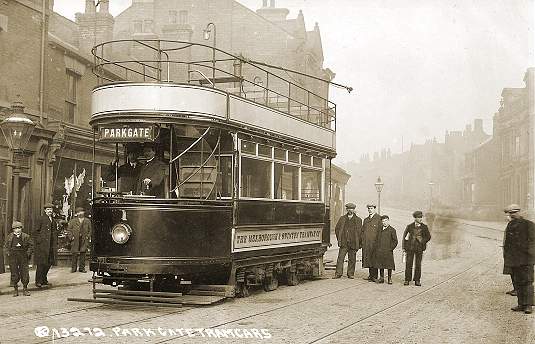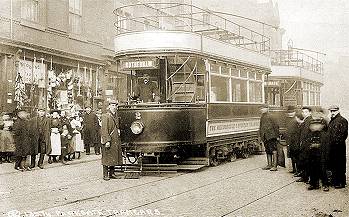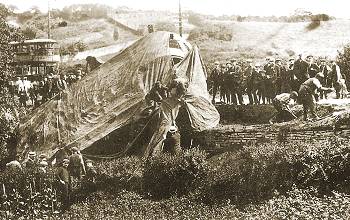

Our superb real photographic postcard (serial number 13272 published by J.Crowther Cox of Rotherham, who produced many real photographic postcards of the Mexborough trams) shows car no.1 of the Mexborough and Swinton Tramways Company in Parkgate, at the bottom of Rawmarsh Hill in 1907. We are looking north in the direction of Swinton and Mexborough and most of the buildings in view still exist today.
Mexborough, Swinton and Rawmarsh are in South Yorkshire and have long been centres for coal-mines, quarries and brickworks, although less so today. There were very early plans in 1876 for a horse tramway in the area between Parkgate and Rotherham to the south. The plans came to nothing as did those of 1881 enshrined in the Parkgate and Rawmarsh Tramways Act. There was genuine progress by 1902 when the Mexborough and Swinton Tramways Company was incorporated by the Mexborough and Rawmarsh Construction Company (M&RCCo).
It was not until 1905 that construction started, the work being carried out by the National Electric Construction Company (successor to the M&RCCo). More for aesthetic reasons than for technical merit, the company was persuaded to use the French Dolter surface contact system, as fully described with our Postcard of Hastings, instead of a conventional overhead wire. The standard-gauge line ran from a connecting point with the Rotherham Corporation tramways (opened in 1903) at Rotherham Bridge, northwards through Parkgate, Rawmarsh and Swinton before turning east to Mexborough and the terminus at Denaby. The entire tramway was only 6.5 miles long.
 A first service opened on 6th February 1907 between the Rotherham boundary and Parkgate, a distance of barely two miles, and was extended a mile north to Rawmarsh on 9th February. Although unposted, our postcard must date from this period, possibly during test running (the driver is not wearing a uniform) or on the first day of service. Someone has written on the back, "Don't you think our cars look lovely? This is taken where the buses used to stand at our street." Another postcard in the same series, no.13274, (left) shows tram no.2 at the same point ready to leave for Rotherham. The route through Mexborough (in the opposite direction) and on to Old Toll Bar at Denaby, was in operation by 3rd August 1907.
A first service opened on 6th February 1907 between the Rotherham boundary and Parkgate, a distance of barely two miles, and was extended a mile north to Rawmarsh on 9th February. Although unposted, our postcard must date from this period, possibly during test running (the driver is not wearing a uniform) or on the first day of service. Someone has written on the back, "Don't you think our cars look lovely? This is taken where the buses used to stand at our street." Another postcard in the same series, no.13274, (left) shows tram no.2 at the same point ready to leave for Rotherham. The route through Mexborough (in the opposite direction) and on to Old Toll Bar at Denaby, was in operation by 3rd August 1907.
Tram no.1 was the first of sixteen open-top trams (1-16) built in 1906 by Brush on Mountain & Gibson radial 4-wheel trucks (replaced by Brush 21E trucks after WW1). Originally, two GE58 motors of 35hp each were fitted and operation was by BTH B18 controllers. Seating was provided for 22 downstairs and 32 upstairs, reached by direct type staircases. Livery was reddish brown and cream with intricate gold lining and the usual ornate lettering and numbering typical of the day.
Four additional trams (17-20) of similar layout arrived in 1908 but these were fitted from new with Brush 21E trucks and open-balcony top covers of a low-roof design because of low bridges at Parkgate and Swinton. Fourteen of the original trams received similar top covers within a few years, the remaining two trams (10 & 14) having been sold by 1911 to Dewsbury & Ossett Tramways. From new, the lower saloon ceilings were 6 inches lower (at 6ft 3in) than normal for the day also to allow for the low bridges.
In our postcard view, the darker Dolter 'studs' (about 1ft square) can just be seen between the running rails and current collection was by means of a 'skate' suspended under the car. As the car passed over, an armature in the studs was induced to rise up and close a contact to make the stud 'live' in order to supply electrical power to the car via the skate. The studs were spaced such that the skate was always in contact with at least one stud. When the car had passed, the armature was designed to drop back down and so the stud became electrically 'dead'. The fact that this did not always happen was the cause of the many problems associated with the Dolter system. A wire brush safety device was hung from the tram's rear bumper, as seen in the small view, and which shorted out live studs blowing a fuse in them and raising an alarm bell on the car. From the start of the tramway the cars were also fitted with normal trolley poles for operation into Rotherham.
 As quickly happened later with the other Dolter surface contact systems in England (Torquay and Hastings, both of which also opened in 1907), reliability and safety were weak points and the company was already in the process of conversion when a Board of Trade inspection enforced the system's closure on 30th July 1908. On a 'workmen's special' early in the morning on that day, tramcar no. 14 (right) derailed between Rawmarsh and Swinton, plunging through a stone wall and into a field. Eighteen people were injured but none fatally. Current collection by conventional overhead wire was completed and the system re-opened a month later. This then allowed Rotherham Corporation trams to operate on the Mexborough tracks for various joint workings.
As quickly happened later with the other Dolter surface contact systems in England (Torquay and Hastings, both of which also opened in 1907), reliability and safety were weak points and the company was already in the process of conversion when a Board of Trade inspection enforced the system's closure on 30th July 1908. On a 'workmen's special' early in the morning on that day, tramcar no. 14 (right) derailed between Rawmarsh and Swinton, plunging through a stone wall and into a field. Eighteen people were injured but none fatally. Current collection by conventional overhead wire was completed and the system re-opened a month later. This then allowed Rotherham Corporation trams to operate on the Mexborough tracks for various joint workings.
No tramway route extensions were built although a connection was made in 1924 with the then new Dearne District Light Railway at Swinton. However, the company was something of a pioneer in 'railless electric traction', i.e. trolleybuses. The first routes were opened in 1915 and from the late 1920s, parts of the tramway were being replaced by a fleet of new Garrett trolleybuses, one of which (no.34) still exists, albeit awaiting restoration.
Tramway operation ceased on 10th March 1929 and the company renamed itself to the Mexborough and Swinton Traction Company, reflecting the fact that it no longer ran trams. Two more trams were sold to Dewsbury & Ossett (7 & 15), the remainder were scrapped. The trolleybus system developed and expanded with numerous second-hand vehicles as well as new deliveries, the last arriving in 1950. During the 1950s, a gradual decline set in and the last trolleybuses were withdrawn on 26th March 1961, giving way to the ubiquitous diesel bus.
Finally, the Mexborough and Swinton Traction Company name disappeared in 1969 when it was absorbed into the Yorkshire Traction Company as part of the National Bus Company. Amazingly, it's still possible to see a tram close to the Parkgate terminus illustrated because less than a mile away is the South Yorkshire Transport Museum in Aldwarke that houses the lower deck of 1926-built Sheffield tramcar no. 430.
(The author of this article wishes to thank the Mexborough & District Heritage Society, the Rawmarsh and Parkgate Local History Group and Mexborough Library for their help in locating exactly where the photograph for the postcard was taken and for other background information).
![]() Go to Postcard Of The Month Index
Go to Postcard Of The Month Index